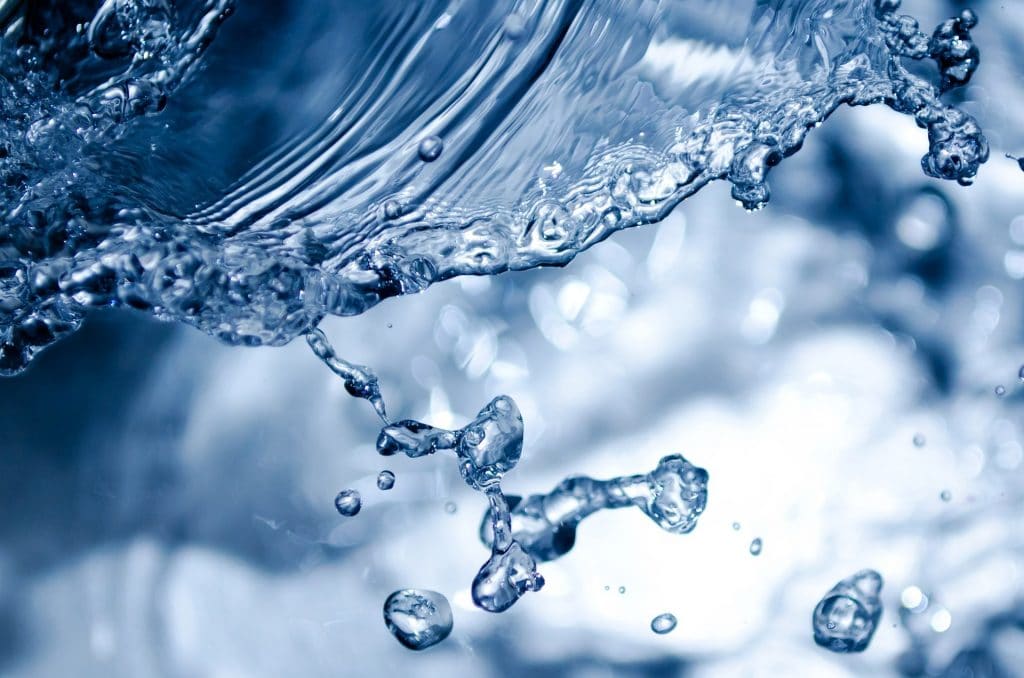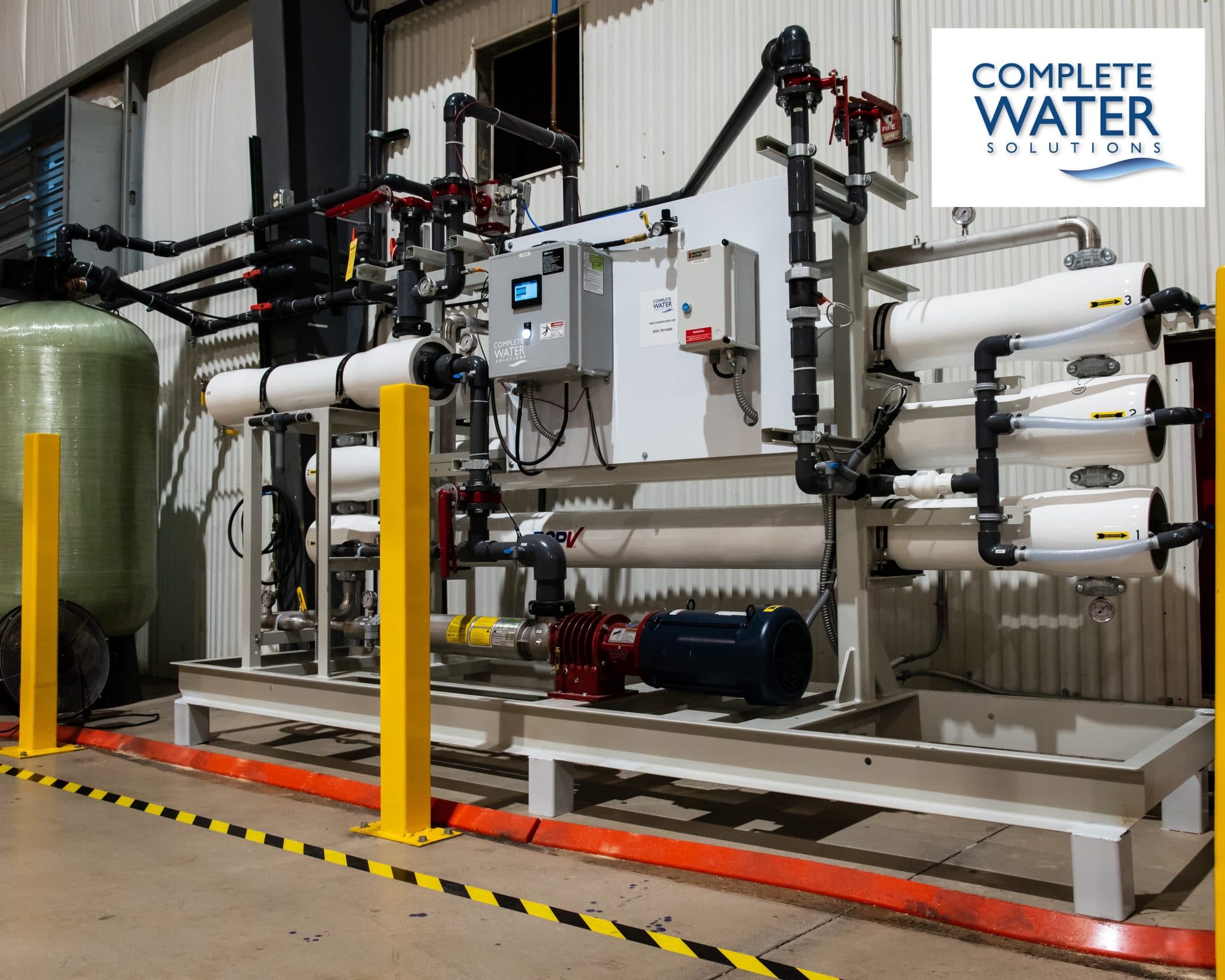
40 GPM Reverse Osmosis System Design From Complete Water
Current System Layout:
The customer current system layout was a duplex softener followed by a Portable DI Exchange Tank. With the current demand for purified water this design was not the best nor most cost-effective option. The increased demand would result in additional salt usage along with significant DI Exchange tank costs.
Design: What Will The RO Water Quality Be?
Prior to design and layout Complete Water Solutions was able to secure a water sample. This sample was sent to a 3rd party lab which helped identify the incoming water quality. Some of the items we tested for were
- Alkalinity “P” as CaC03
- Alkalinity “M” as CaCO3
- Fluoride
- Nitrate NO3
- TOC
- NTU
- Potassium
- Sodium Na
- Chloride CL
- Phosphate Ortho
- Conductivity @ 25c
- Aluminum AL
- Barium
- Hardness Total CaCO3
- Copper Total
- Iron Total
- Sulfur Total
- Silica Total
Based off of the water analysis received we were able to perform a projection analysis. The projection analysis will help us provide a permeate water quality estimate. (Good RO Water). This analysis also helped in identifying the best design, membranes and options available for the application.
This particular analysis spotted iron as a significant factor in potential fouling and that reducing it would be beneficial to the RO membrane performance along with recovery. The higher the recovery the less wastewater the RO will produce. Increasing the recovery too much can result in fouling. It’s a good practice to consult with your water treatment equipment provider to discuss ways to reduce waste water.
This water source is chlorinated, and if not treated can cause irreversible damage. A carbon filter was selected as the main solution to remove the chlorine prior to the RO System.
Another benefit of having the water analyzed is to help in selecting the best antiscalant. Antiscalant is used to control scale forming on the surface of the RO membrane. If left untreated it can foul the membranes or cause irreversible damage. Not all antiscalants are the same, some products will work better for certain contaminants. Getting your water tested can help minimize water quality and equipment problems.
Scope:
Based on current and future demands, we were able to determine that a 35-40 Gallons Per Minute Reverse Osmosis System would be the most beneficial. The new water system design eliminated the need for a water softener and portable DI Exchange Tanks.
The machine used in this project was a LT8-9. This was the new design by Veolia that replaced the E8-57K Machine. This machine was selected for a few reasons:
- The first reason for selecting the LT8-9 was the options. The customer future plans required the ability to produce more RO water. The LT8-9 allowed us to install a larger pump and motor on the unit, thus eliminating the future cost of adding a larger pump and motor. It was already taken care of in this original purchase. The only thing to do in the future will be the addition of RO housings and membranes (with a little pvc piping). This will save costs and longer down times during the upgrade.
- The 2nd reason was the ability to select cold water membranes. (Learn More About Different Membranes- Click Here). Most membranes are rated at 77 Degrees F for output production. Cold water membranes will allow you to operate at 55 Degree F and provide the same output. This reduces costs of pre-heating the water prior to the RO System.
- The 3rd reason is the pump and motor. Tonkaflo pumps have been around along time and are very robust. Learn More About Tonkaflo Pumps
The RO System was able to be up and operational in (2) two 12 hour days of installation. This included the soaking time required for the carbon filter media. The system specifications:
- System Inlet Filtration: Bag filtration installed prior to the carbon filter to help trap particulate greater than 1 micron. The bag filter housing was stainless steel with a high efficiency 1 micron bag filter.
- Carbon Filter: The carbon filter selected was a Fleck 3150 valve with the new NXT2 Digital Controller. The carbon filter is equipped with a regeneration lock out switch to turn of the RO system during backwash. This will save the membranes from experiencing contact with chlorinated water.
- Antiscalant: The antiscalant selected is a NSF 61 drinking water approved product. The product was selected based on the ability to run the RO at a higher recovery rate which will reduce the wastewater. The antiscalant chemical pump selected was a Grundfos DDA pump which has a 3000:1 turn down ration. This allows for neat feeding of the chemical product. No diluting or mixing.
- RO System: The RO System is a Veolia Model LT8-9. The unit is a 8” Membrane unit with 9 membrane elements. The system was equipped with a Horner PLC and HMI. Additional features included: Permeate Conductivity Probe, Water Temp Sensor, Inlet Pressure Safety Switch, Flow Meters, Inter-stage Pressure Gauges.
Do you need help with your water system?
Contact CWS (855) 787-4200 info@complete-water.com
With over 30 years of hands-on experience in the water treatment industry, Nathan Olszak is a trusted water treatment expert. He specializes in designing, engineering, and servicing water treatment systems. As the owner of Complete Water Solutions, Osmonics, and Membrane Cleaning Pro, Nathan has built a reputation for delivering customized water treatment solutions that enhance efficiency, reliability, and water quality across various industries, including the medical, commercial, and manufacturing sectors.
Nathan’s journey in water treatment began as a service technician. He gained in-depth knowledge by working with all major brands of equipment, including Veolia, Suez, Bruner, Culligan, Pentair, Aquamatic, Osmonics, GE Water, Marlo, Lakeside, Fleck, Autotrol, US Filter, ION Pure, Siemens, Evoqua, and many others. This hands-on expertise, combined with his technical certifications, has made him a leader in water system engineering and water management.
Credentials & Expertise
- Certifications: David H. Paul Reverse Osmosis Certification, PLC Programming
- License: Power Plant Operating Engineer 3rd Class
- Specialties:
- Design & engineering of water treatment systems and advanced water systems
- Custom water filtration systems and solutions
- Installation, automation, and repair of water treatment systems
- Expertise in Reverse Osmosis (RO), Deionization, Water Softening, Carbon Filtration, Iron Filtration, UV Treatment, Ultrafiltration (UF), Process Filtration, CEDI/EDI, and more
- Specialized knowledge in Boiler Feed Water, Tower Makeup Water, and drinking water production for industries such as bottling, pharmaceuticals, and food processing
- Project management and reclaiming of water system waste for other uses
- Evaluation of raw water sources and potential contamination risks
- Industrial water treatment strategies to prevent corrosion and optimize system performance
- Boiler water treatment to enhance energy efficiency and system longevity
Nathan’s commitment to excellence extends beyond equipment sales and service. He works closely with clients to develop tailored water treatment services that optimize performance and meet their operations’ unique demands. His expertise covers methods that mitigate water impurities, ensure fresh water accessibility, and maintain regulatory compliance. It also includes the design of high-efficiency reverse osmosis systems for industrial use.
Nathan focuses on the latest technology in water conditioning, water softeners, filters, and pumps to improve maintenance and efficiency. His experience in laboratory testing and biofilm control ensures the highest industry standards in water treatment processes and water management.
Additionally, his deep understanding of infrastructure and water data analysis provides long-term, cost-effective solutions that promote health and safety. His expertise ensures that businesses receive top-tier, quality water treatment solutions.
For insights into the latest industry trends, innovations, and best practices, explore the Complete Water Solutions Blog, where Nathan shares valuable information on water filtration systems, sustainability, and water solutions engineering.
Give Us A Call (855) 787-4200 or Email info@complete-water.com

